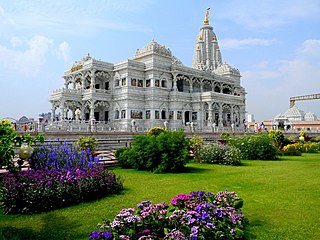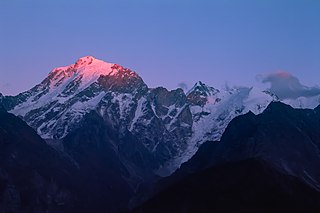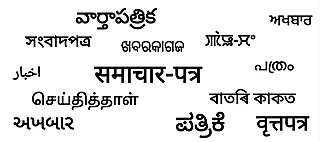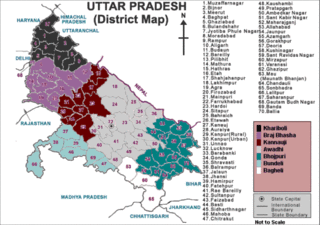Related Research Articles

Uttar Pradesh is a state in northern India. With over 241 million inhabitants, it is the most populated state in India as well as the most populous country subdivision in the world – more populous than all but three other countries outside of India. – accounting for 16.5% of the total population of India. It was established in 1950 after India had become a republic. It is a successor to the United Provinces, established in 1935 by renaming of the United Provinces of Agra and Oudh, in turn established in 1902 from the North-Western Provinces and the Oudh Province. Lucknow serves as the state capital, with Prayagraj being the judicial capital.

North India, in a broader geographic context, typically refers to the northern part of India, encompassing the entire northern half of the country, excluding the southern states. In a more specific and sometimes cultural or administrative sense, North India can also be used to denote a smaller region within this broader expanse, often centered around the northern Indus Basin, the Ganga-Yamuna Doab and the Thar Desert.
BIMARU is an acronym, coined by demographer Ashish Bose in mid-1980s, formed from the first letters of names of some of poorest Indian states, namely Bihar, Madhya Pradesh, Rajasthan, and Uttar Pradesh. BIMARU in Hindi, bīmār (बीमार), denotes "sick" states referring to the poor economic conditions of these states. BIMARU states are low on HDI & food security. The present-day states of Chhattisgarh, Jharkhand and Uttarakhand were part of Madhya Pradesh, Bihar and Uttar Pradesh, respectively, when the BIMARU acronym was coined. All of these are in Hindi Belt, which also has relatively richer non-BIMARU states, such as Haryana, Himachal Pradesh, Delhi, Chandigarh and Uttarakhand.

Ghagra choli is a type of ethnic clothing for women from the Indian Subcontinent, notably in the Indian states of Rajasthan, Gujarat, Madhya Pradesh, Uttar Pradesh, Bihar, Haryana, Punjab, Himachal Pradesh, Uttarakhand, Jammu and Kashmir, as well as in the Pakistani provinces of Punjab and Sindh. In Punjab, the lehenga is traditionally worn with a kurti. It is a combination of the gagra or lehenga and the choli (blouse), however in contemporary and modern usage lehenga choli is the more popular and widely accepted term by fashion designers, trend setters, and boutiques in South Asia, since ghagra is synonymous with the half-slip worn as an undergarment below the sari.

Panjiri is a Ayurvedic sweet dish from the Indian subcontinent which is specially prepared for Krishna Janmashtami festival. The sweet panjiri evolved from an Ayurvedic preparation called Panchajīraka.

A ghoonghat is a headcovering or headscarf, worn primarily in the Indian subcontinent, by some married Hindu, Jain, and Sikh women to cover their heads, and often their faces. Generally aanchal or pallu, the loose end of a sari is pulled over the head and face to act as a ghoonghat. A dupatta is also commonly used as a ghoongat.
The Khatik is a Hindu caste found in the Indian subcontinent, mainly modern-day India, Pakistan and Nepal. Khatik have a population of approximately 10 millions and are located mainly in New Delhi, Haryana, Rajasthan, Madhya Pradesh, Uttar Pradesh, Maharashtra, Telangana, Andhra Pradesh and Himachal Pradesh. Traditionally, they are the community of vegetable cultivators and butchers and many of them are involved in the same business. According to William Crooke, the word Khatik is derived from the Sanskrit word khattika meaning butcher or hunter.

Hindi media refers to media in Hindi language and its dialects, across the Hindi belt in India, and elsewhere with the Hindi-speaking Indian diaspora.
The Kunjra are a community found in North India, Central India and Nepal. They are also known as Sabzi Farosh or Mewa Farosh. Kunjra, by definition, means a vegetable seller or greengrocer. It denotes an occupation rather than a caste.
The Rangrez are a Muslim community found in North India. They are also known as Sabagh. Many members of Muslim Rangrez community have migrated to Pakistan after independence and have settled in Karachi, Sindh.
The Patwa are a mainly Hindu community native to Hindi Belt.Traditionally, they were Hindu baniya.
The Ghosi are a Muslim community found mainly in North India.

Nai, also known as Sain/Sen, is a generic term for occupational castes of barbers. The name is said to be derived from the Sanskrit word nāpita (नापित). In modern times Nai in northern India refer to themselves as "Sain" instead of Nai.
This is a list of notable people using Yadav surname.

Chhipi is a caste of people with ancestral roots tracing back to India. They are found in the states of Gujarat, Rajasthan, Madhya Pradesh, Haryana, Delhi, Uttar Pradesh of India. Chhipa are also found in Pakistan.
Groom kidnapping, colloquially known as Pakaruah shaadi or Jabaria shaadi, is a phenomenon in the western parts of Bihar and eastern Uttar Pradesh states, more prominent in Munger and Dumka wherein eligible bachelors are abducted by the bride's family and later forcibly married, to get men with better education and/or richer men. Considering the traditional regard for the marriage sacrament, most such marriages are not annulled. Additionally, the groom may suffer fake criminal charges under Indian dowry law, and end up fighting lengthy legal battles.

Western Uttar Pradesh is a region in India that comprises the western districts of Uttar Pradesh state, including the areas of Rohilkhand and those where Khariboli, Braj and Kannauji are spoken. The region has some demographic, economic and cultural patterns that are distinct from other parts of Uttar Pradesh, and more closely resemble those of Haryana and Rajasthan states. Western Uttar Pradesh has experienced rapid economic growth, in a fashion similar to Haryana and Punjab, due to the successes of the Green Revolution. A significant part of western Uttar Pradesh is a part of National Capital Region of India. The largest city of the region is Ghaziabad, while the second-largest city, Agra, is a major tourist destination.

News Nation is an Indian free to air Hindi news television channel. News Nation is owned by News Nation Network Pvt Ltd.

Anil Chaudhary is an Indian director, producer and screenwriter. He is the maker of notable television shows such as Mahayagya (1997), Phatichar (1991), Kabeer (1986) and Gunwale Dulhania Le Jayenge (2009). He is credited with writing television shows such as Karamchand, Nukkad and Rajani. He also authored and directed numerous theatre plays one of which is 'Chopra Kamaal Naukar Jamal' that was adapted from Bertolt Brecht's play 'Mr. Puntila and his man Matti'.
References
- ↑ Anil Chawla (7 March 2002). "CHILD MARRIAGES - Need for Better Understanding of Customs". Samarthbharat.com. Retrieved 7 June 2012.
- ↑ Sethi NK, Rao SS, Aggarwal OP, Abhaya Indrayan, Chuttani CS. "Age at Marriage, Gauna (effective marriage) and first child birth in rural women: changing pattern in various marriage cohorts by decades". Medind.nic.in. Retrieved 7 June 2012.
{{cite web}}: CS1 maint: multiple names: authors list (link) - ↑ Charan D. Wadhva; B. N. Saxena; Om Prakash Sharma (2003). Population Stabilization Through District Action Plans: Bihar, Madhya Pradesh, Rajasthan, and Uttar Pradesh. APH Publishing. p. 237. ISBN 978-81-7648-514-2.
- ↑ Murthy, Padmini; Clyde Lanford Smith (25 October 2010). Women's Global Health and Human Rights. Jones & Bartlett Learning. p. 512. ISBN 978-0-7637-5631-4 . Retrieved 7 June 2012.
- ↑ Nirula (2009). Women Problems & Their Oprression in U.p. APH Publishing. p. 75. ISBN 978-81-313-0470-9 . Retrieved 7 June 2012.
- ↑ "Gauna Hindi movie, movie reviews, cast, song lyrics and photos - bollywood". Whereincity.com. Retrieved 7 June 2012.
- ↑ "Zee TV Official Website: Zee TV Shows, Zee TV Serials Online, Videos". zeetv.com. Archived from the original on 16 March 2012. Retrieved 7 June 2012.
- ↑ "Smita Bansal gets nostalgic on Sugna's Gauna". Realbollywood.com. 23 February 2009. Archived from the original on 13 July 2009. Retrieved 7 June 2012.